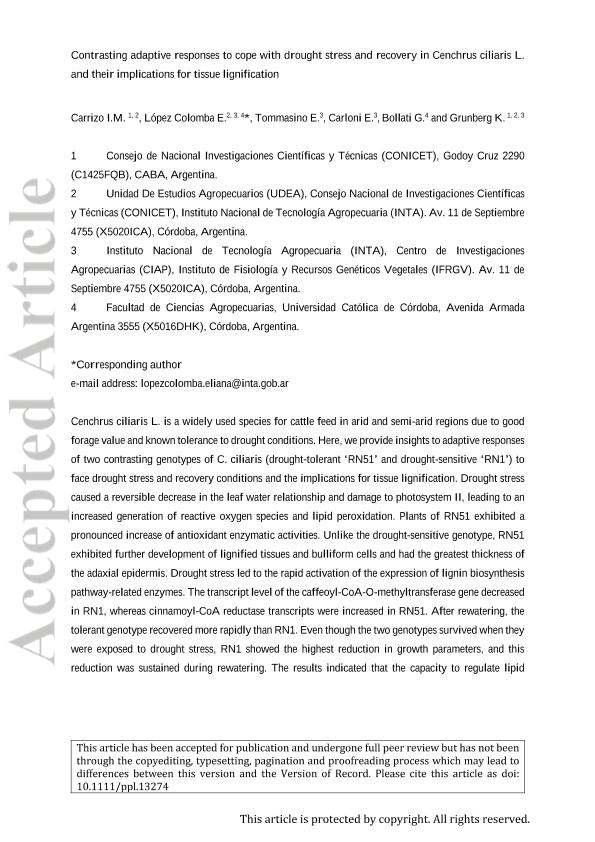Artículo
Contrasting adaptive responses to cope with drought stress and recovery in Cenchrus ciliaris L. and their implications for tissue lignification
Carrizo, Iliana Magalí ; Lopez Colomba, Eliana
; Lopez Colomba, Eliana ; Tommasino, Exequiel Arturo; Carloni, Edgardo José; Bollati, Graciela; Grunberg, Karina Alejandra
; Tommasino, Exequiel Arturo; Carloni, Edgardo José; Bollati, Graciela; Grunberg, Karina Alejandra
 ; Lopez Colomba, Eliana
; Lopez Colomba, Eliana ; Tommasino, Exequiel Arturo; Carloni, Edgardo José; Bollati, Graciela; Grunberg, Karina Alejandra
; Tommasino, Exequiel Arturo; Carloni, Edgardo José; Bollati, Graciela; Grunberg, Karina Alejandra
Fecha de publicación:
06/2021
Editorial:
Wiley Blackwell Publishing, Inc
Revista:
Physiologia Plantarum
ISSN:
0031-9317
Idioma:
Inglés
Tipo de recurso:
Artículo publicado
Clasificación temática:
Resumen
Cenchrus ciliaris L. is a widely used species for cattle feed in arid and semi-arid regions due to good forage value and known tolerance to drought conditions. Here, we provide insights to adaptive responses of two contrasting genotypes of C. ciliaris (drought-tolerant “RN51” and drought-sensitive “RN1”) to face drought stress and recovery conditions and the implications for tissue lignification. Drought stress caused a reversible decrease in the leaf water relationship and damage to photosystem II, leading to an increased generation of reactive oxygen species and lipid peroxidation. Plants of RN51 exhibited a pronounced increase of antioxidant enzymatic activities. Unlike the drought-sensitive genotype, RN51 exhibited further development of lignified tissues and bulliform cells and had the greatest thickness of the adaxial epidermis. Drought stress led to the rapid activation of the expression of lignin biosynthesis pathway-related enzymes. The transcript level of the caffeoyl-CoA O-methyltransferase gene decreased in RN1, whereas cinnamoyl-CoA reductase transcripts were increased in RN51. After rewatering, the tolerant genotype recovered more rapidly than RN1. Even though the two genotypes survived when they were exposed to drought stress, RN1 showed the highest reduction in growth parameters, and this reduction was sustained during rewatering. The results indicated that the capacity to regulate lipid peroxidation and mitigate oxidative damage could be one of the mechanisms included in tolerance to drought stress. In addition, the development of foliar characteristics, like thickness of the adaxial epidermis, well-developed bulliform cells, and intensive lignified tissues, are considered anatomical adaptive strategies for drought tolerance in C. ciliaris.
Palabras clave:
CENCHRUS CILIARIS
,
DROUGTH STRESS
,
LIGNIFIED TISSUES
,
GROWTH PARAMETERS
Archivos asociados
Licencia
Identificadores
Colecciones
Articulos (UDEA)
Articulos de UNIDAD DE ESTUDIOS AGROPECUARIOS
Articulos de UNIDAD DE ESTUDIOS AGROPECUARIOS
Citación
Carrizo, Iliana Magalí; Lopez Colomba, Eliana; Tommasino, Exequiel Arturo; Carloni, Edgardo José; Bollati, Graciela; et al.; Contrasting adaptive responses to cope with drought stress and recovery in Cenchrus ciliaris L. and their implications for tissue lignification; Wiley Blackwell Publishing, Inc; Physiologia Plantarum; 172; 2; 6-2021; 762-779
Compartir
Altmétricas



